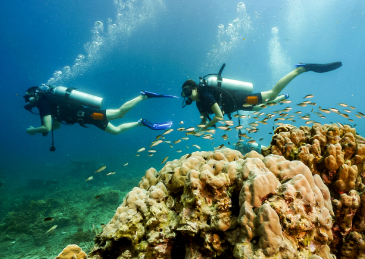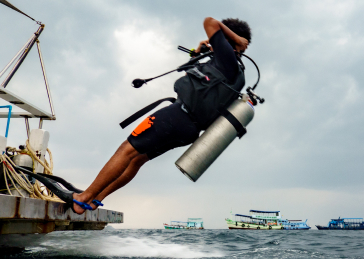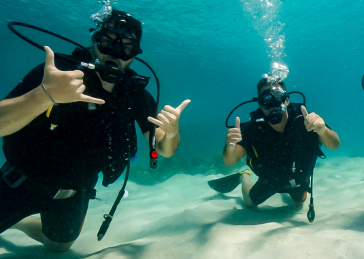7th May 2024
Scuba diving in Koh Tao isn’t just about the thrill and the beauty of the underwater world; it’s about doing so safely and responsibly. Before you dive in, there are some essential protocols and tips you need to know. In this article we’ll look into the safety measures that will make your underwater adventure both memorable and secure.
Preparing for Your Dive Adventure on Koh Tao: A RAID Diver’s Checklist
Before you even think about getting wet, you need to ensure you’re prepared. That means understanding the RAID Open Water training requirements, assessing your health and fitness, packing the right gear, and knowing the best times to dive in Koh Tao. This checklist is your first step towards a safe and enjoyable dive.
Understanding RAID Open Water Training Requirements
The RAID Open Water course is your gateway to the underwater world. It covers the basics of scuba diving, including equipment usage, dive planning, and underwater navigation. To enroll, you should be comfortable in the water and in good health. Most importantly, you’ll need a sense of adventure and a commitment to learning.
Pre-Dive Health Assessment and Fitness Considerations
Your health and fitness level are crucial to a safe dive. Before diving, perform a self-assessment. Are you feeling well? Have you had enough rest? If you’re under the weather or even just feeling off, it’s better to postpone your dive. Diving is demanding, and you need to be at your best.
Essential Gear Checklist for a Safe Dive
Having the right gear is non-negotiable. At a minimum, your dive kit should include a mask, snorkel, fins, regulator, buoyancy control device (BCD), and a dive computer to keep track of your depth and bottom time. Your gear should be in good condition and familiar to you. If you’re renting, take the time to get acquainted with it before your dive.
Weather and Water Conditions: Best Times for Diving on Koh Tao
Koh Tao’s dive conditions vary throughout the year. The best visibility and calmest seas are typically from July to September. However, diving is possible year-round. Always check the local weather and sea conditions before your dive. Strong winds and rough seas can turn a dive unsafe in a heartbeat.
Mastering the Art of Buoyancy Control for Safer Dives
Buoyancy control is at the heart of a safe and enjoyable dive. It’s what keeps you from bouncing around like a yo-yo underwater. Good buoyancy control starts with proper weighting and is perfected through practice. It’s not just about your comfort; it’s also about protecting the delicate marine environment.
RAID Buoyancy Performance Workshop: What You’ll Learn
In the RAID buoyancy performance workshop, you’ll learn the ins and outs of achieving perfect buoyancy. This means understanding how to adjust your BCD, how to distribute weight evenly, and how to use your breath to fine-tune your buoyancy. It’s a game-changer for your diving experience.
Practical Exercises for Perfecting Your Buoyancy
- Hovering motionless in the water column.
- Gliding effortlessly over a reef without touching it.
- Ascending and descending smoothly and with control.
These exercises will help you become one with the water, moving within it as if you were a part of it. Practice makes perfect, and the more you dive, the better your buoyancy will become. For more tips on dive safety and control, check out 8 Easy Steps to Ensure Scuba Diving Safety.
Role of Proper Weighting in Buoyancy Management
Overweighting is a common issue for divers, leading to excessive BCD inflation and, as a result, faster air consumption. On the flip side, underweighting can make it hard to stay down. You’ll learn to find that sweet spot where you’re neither sinking like a stone nor floating up uncontrollably.
Conservation Considerations: How Good Buoyancy Protects Marine Life
Every time you dive, you’re visiting the home of countless marine creatures. Good buoyancy control means you’re less likely to damage coral or disturb wildlife. It’s a sign of respect for the ocean and everything that calls it home.
Discovering the Importance of Dive Planning with RAID
When it comes to scuba diving, planning is not just a suggestion; it’s a necessity. A well-thought-out plan ensures you know what to expect underwater, helps you manage your air supply efficiently, and prepares you for the unexpected. Dive planning is not about taking the fun out of diving; it’s about making sure you can keep having fun safely.
Charting Your Dive: Step-by-Step Guide
Start by defining your dive objectives. Are you exploring a reef, photographing marine life, or simply enjoying the sensation of weightlessness? Next, consider depth, duration, and the route you’ll take. Always plan your dive with your buddy, and make sure you both agree on every aspect. Here’s a simple guide:
- Decide on the maximum depth and bottom time.
- Agree on a route and points of interest.
- Plan for regular air checks and a safety stop.
- Have a contingency plan for potential problems.
Recognizing and Managing Potential Hazards
Being aware of potential hazards is a big part of dive planning. Currents, visibility, and marine life behavior can all impact your dive. By acknowledging these factors, you can take proactive steps to mitigate risks. For instance, if strong currents are expected, plan to dive at slack tide or choose a more sheltered dive site.
Navigational Skills: Using Natural and Compass References
Navigational skills are essential, especially in unfamiliar waters. Use natural landmarks like reef formations or man-made ones like mooring lines to help orient yourself. A compass is your best friend underwater; practice using it on land to build confidence. Remember, a good diver always knows the way back to the boat or shore.
RAID’s Approach to Gas Management and Air Consumption Estimates
One of the golden rules of diving is to never run out of air. RAID emphasizes gas management, teaching you to monitor your air supply and plan your dive so that you surface with a reserve. Use the rule of thirds: one-third of your air for the outward journey, one-third for the return, and one-third as a safety reserve.
Emergency Preparedness: RAID Rescue Diver Techniques
Emergencies can happen, even to the most experienced divers. That’s why RAID’s Rescue Diver course is all about being prepared. It’s not just about knowing what to do in an emergency; it’s about preventing one from happening in the first place. This course is an investment in your safety and the safety of others.
Developing a Proactive Mindset: Prevention over Cure
Being proactive means checking your gear, diving within your limits, and always being aware of your surroundings. It’s about anticipating problems before they occur and having a plan to deal with them. Prevention is always better than a cure, especially underwater where every second counts.
Training Scenarios: Handling Diving Emergencies
The RAID Rescue Diver course will put you through a series of simulated emergencies. You’ll learn how to deal with panicked divers, missing divers, and unconscious divers both at the surface and underwater. These scenarios will teach you to stay calm and act effectively in a real emergency.
Essential First Aid Skills for Divers
First aid skills are vital for any diver. Knowing how to administer oxygen, perform CPR, and treat injuries can make the difference between life and death. RAID’s first aid training is thorough, giving you the confidence to help in an emergency and the knowledge to possibly save a life.
Surface and Underwater Rescue Skills Practice
Practicing rescue skills in both surface and underwater situations is crucial. You’ll learn how to approach and assist a distressed diver, manage an unconscious diver, and even provide in-water resuscitation if necessary. These skills are not just for professional divers; they’re for anyone who takes diving safety seriously.
Advancing Your Skills: RAID Speciality Diver Courses

Once you’ve mastered the basics, it’s time to expand your skills. RAID offers a range of specialty courses that allow you to explore new environments, extend your dive times, and even contribute to marine conservation. Let’s look at some of the courses that can take your diving to the next level.
Deep Diver Speciality: Exploring New Depths
The Deep Diver specialty takes you beyond the usual recreational dive limits, down to depths where the light fades and the water’s pressure is palpable. You’ll learn about the physiological effects of deeper diving, how to manage your gas supply, and how to deal with potential issues like nitrogen narcosis.
Enriched Air Nitrox Course: Longer Bottom Times and Safer Profiles
Diving with enriched air nitrox lets you extend your bottom times and reduce your surface intervals. This course teaches you how to analyze your gas mix, set your dive computer for nitrox, and plan dives that maximize the benefits of breathing oxygen-enriched air.
Wreck Diver Speciality: Safely Navigating Underwater Structures
Wrecks are fascinating windows into the past, but they also pose unique risks. The Wreck Diver specialty shows you how to safely explore these underwater time capsules. You’ll learn about penetration diving, line-laying techniques, and how to avoid silt-outs and other hazards.
Marine Ecology Speciality: Understanding and Preserving Ocean Life
The ocean is more than just a playground for divers; it’s a complex ecosystem that needs our protection. The Marine Ecology specialty educates you on the relationships between different marine organisms and how you can dive in a way that minimizes your impact on these delicate systems.
Navigating the Night: Tips for Safe Night Diving on Koh Tao
When the sun sets, the underwater world of Koh Tao transforms. Night diving offers a new perspective on familiar dive sites, but it also requires additional precautions. To dive safely at night, you need to be prepared, be aware, and be equipped with the right gear.
Planning Your Night Dive: RAID Protocols to Follow
RAID’s night diving protocols emphasize thorough planning and clear communication. Before your dive, discuss entry and exit points, navigation plans, and emergency procedures. Choose a familiar site for your first night dive and make sure you and your buddy both have a reliable dive light.
Night Diving Equipment: Lights, Signaling Devices, and Backup Gear
- Primary dive light: Your main source of illumination.
- Backup light: In case your primary light fails.
- Marker lights: Attached to your gear for visibility.
Signaling devices, such as strobes or glow sticks, are also essential for night dives. They help you communicate with your buddy and make you visible to the boat or other divers.
Communication and Buddy System Adjustments for Low Visibility
At night, the usual hand signals might not be enough. Develop a set of light signals with your buddy, such as shining your light in a circle for ‘okay’ or moving it back and forth for ‘attention’. Staying close to your buddy is crucial, as it’s easier to lose track of each other in the dark.
Marine Life After Dark: What to Expect and Observe
Many marine creatures are nocturnal, so night diving in Koh Tao can be a unique opportunity to observe different behaviors and species. Remember to respect their space and avoid shining your light directly into their eyes, as this can disorient and disturb them.
Sustainable Diving Practices with RAID: Protecting Koh Tao’s Ecosystem
Diving is not just about the excitement of exploring the underwater realm; it’s also about doing so in a way that ensures the health and longevity of the ecosystem. RAID divers are taught to dive sustainably, with an emphasis on conservation and eco-friendly practices.
RAID’s Philosophy on Conservation and Responsible Diving
RAID promotes a philosophy of conservation-minded diving. This includes being aware of your surroundings, avoiding contact with marine life, and adhering to no-take and no-touch rules. By diving responsibly, you help preserve the underwater environment for future generations.
Implementing Eco-Friendly Diving Techniques
Eco-friendly diving techniques are simple yet effective. They include:
- Maintaining good buoyancy to avoid damaging the reef.
- Using reef-safe sunscreen to protect marine life.
- Minimizing the use of plastics and properly disposing of waste.
By adopting these practices, you play an active role in protecting the marine environment.
Participation in Local Conservation Efforts and Citizen Science
Engage with local conservation efforts by participating in reef cleanups or citizen science projects. These activities not only contribute to the health of the ecosystem but also enrich your diving experience with a sense of purpose and community involvement.
Reducing Your Environmental Footprint as a Diver
Every diver has a responsibility to minimize their environmental impact. Choose eco-friendly dive operators, support conservation initiatives, and spread awareness about sustainable diving practices. Your actions, both in and out of the water, make a difference.
Creating Lasting Memories: Underwater Photography with RAID Guidelines
![]()
“Ocean Preservation Images | Free Photos …” from www.rawpixel.com and used with no modifications.
Underwater photography is a fantastic way to capture the magic of Koh Tao’s aquatic landscape. With RAID’s guidelines, you can take stunning photos while ensuring you don’t harm the environment or disturb marine life.
Introduction to Underwater Photography: Equipment and Settings
For underwater photography, you’ll need a camera with a waterproof housing and an understanding of the unique settings required for underwater shots. Start with a simple camera setup and learn how to adjust white balance, shutter speed, and aperture for the best results.
Composing Your Shots: Techniques for Capturing Koh Tao’s Beauty
Good composition is key to great underwater photography. Look for interesting subjects and use techniques like the ‘rule of thirds’ to create balanced and engaging images. Always be patient and wait for the perfect moment to capture the essence of the underwater world.
Respecting Wildlife While Getting the Perfect Photo
While it’s tempting to chase that perfect shot, it’s crucial to respect wildlife and their habitats. Avoid touching or stressing animals, and be mindful of your buoyancy and movements to prevent damaging the reef or stirring up sediment.
Post-Dive Photo Review and Editing Tips
After your dive, take the time to review and edit your photos. Simple adjustments to contrast, brightness, and color can bring out the best in your underwater images. Remember to share your photos responsibly, without revealing sensitive locations that could be harmed by increased visitor traffic.
Key Takeaways
- Preparation is key to a safe and enjoyable dive in Koh Tao.
- Master buoyancy control to protect marine life and enhance your dive experience.
- Plan your dives carefully, considering all potential hazards and environmental conditions.
- Invest in emergency preparedness and rescue diver training for peace of mind.
- Advance your skills with specialty courses to explore new depths and perspectives.
- Adopt sustainable diving practices to protect Koh Tao’s delicate ecosystem.
- Embrace underwater photography, but always prioritize the well-being of marine life.
FAQs
What Are the Prerequisites for Becoming a RAID Open Water Diver?
To become a RAID Open Water Diver, you need to be at least 15 years old, have adequate swimming skills, and be in good physical health. No prior experience with scuba diving is required, but a passion for learning and respect for the ocean are essential.
How Does Proper Buoyancy Impact Dive Safety?
Proper buoyancy control is vital for dive safety because it helps you conserve air, move efficiently underwater, and avoid damaging the reef or disturbing marine life. It also reduces the risk of decompression sickness by facilitating controlled ascents and descents.
Why Is Dive Planning Essential Even for Experienced Divers?
Dive planning is essential because it prepares you for the conditions you’ll face underwater, helps you manage your air supply, and ensures you have a strategy for handling potential emergencies. No matter how experienced you are, a well-thought-out dive plan is a cornerstone of safe diving.
What Are the Key Skills Taught in the RAID Rescue Diver Course?
The RAID Rescue Diver course teaches you to prevent and manage problems in the water, improve your skills and confidence, and become a better buddy by practicing problem-solving skills. This includes learning to identify stress, administering first aid, and performing diver rescues and assists.
Dive with LBD: Your Gateway to Underwater Exploration
Whether you’re a curious beginner or a seasoned pro, our school is your portal to the wonders of scuba diving. Join us into the world beneath the waves.
READY TO GET STARTED?
Check our diving courses in Koh Tao



